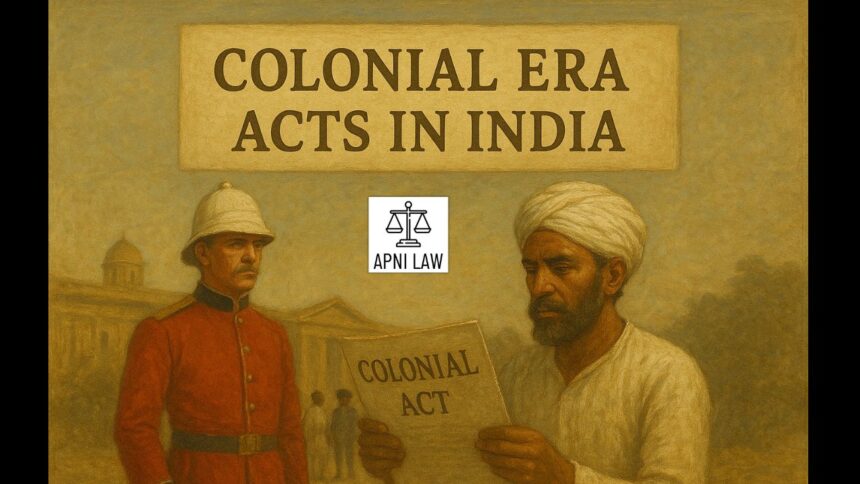Introduction
The Government of India Act of 1858 marks a watershed moment in the history of colonial India. For over two centuries, the East India Company had dominated India’s politics, economy, and governance. However, the Revolt of 1857, often called the First War of Independence, exposed the Company’s failures and shook British confidence in its ability to rule. The Act of 1858 was passed as an immediate response, transferring power directly from the East India Company to the British Crown. This Act ended Company raj and ushered in direct Crown rule, symbolizing both a political and administrative transformation. By studying this law, we understand how India’s governance shifted from a private corporation to a structured colonial state under Britain.
Background to the Act of 1858
The East India Company had gradually evolved from a trading body to a political power through battles such as Plassey (1757) and Buxar (1764). With the Regulating Act of 1773 and subsequent Charter Acts, the British Parliament had already begun supervising the Company. Yet, ultimate authority remained with the Company’s directors in London.
The Revolt of 1857, however, proved a turning point. Sparked by grievances over land policies, religious interference, and military discontent, the uprising spread across north and central India. Though suppressed, it revealed deep flaws in Company administration. British politicians in London realized that continued rule by a trading company endangered imperial interests. Thus, Parliament enacted the Government of India Act 1858, formally dissolving the Company’s rule and placing India under direct authority of the British Crown.
Provisions of the Government of India Act 1858
The Act of 1858 brought sweeping administrative reforms. It dissolved the East India Company, ending its dual role as trader and ruler. All territories previously under the Company were declared to be under the sovereignty of the British Crown.
A new office of the Secretary of State for India was created in London. The Secretary, a member of the British Cabinet, held complete control over Indian administration. He was assisted by a Council of India, composed of experienced members, mostly former Company officials. This ensured that Indian governance was directly linked to the British Parliament.
In India, the post of Governor-General was retained but redesigned as the Viceroy of India, representing the Crown. Lord Canning, who suppressed the Revolt of 1857, became the first Viceroy. The Viceroy continued to preside over the Governor-General’s Council but now acted as the monarch’s direct representative.
The Act also centralized administration, bringing the Indian Army, civil services, and financial matters firmly under Crown control. It emphasized a more structured bureaucracy, ensuring that no major decision about India could be made without Parliament’s oversight.
Impact of the Act of 1858
The shift from Company to Crown rule changed the nature of colonial governance. Indians no longer answered to a private corporation but to the British government itself. This gave colonial policies greater legitimacy in Britain and removed ambiguity about sovereignty.
One of the most significant outcomes was the new bureaucratic structure. The Secretary of State in London had far-reaching powers, while the Viceroy acted as his agent in India. This created a highly centralized system where Indian voices remained excluded. Policies, laws, and military decisions were all framed with Britain’s imperial interests in mind.
The Act also reassured Indian princes and landlords. Queen Victoria’s Proclamation of 1858 promised that their rights, religions, and customs would be respected. It declared that India would not face further annexations like those under the Doctrine of Lapse. Though this was a political move to gain loyalty, it temporarily pacified some discontented sections.
At the same time, the Act consolidated British military power. The Crown reorganized the army to prevent another rebellion, increasing the ratio of Europeans to Indians and dividing Indian soldiers by caste, community, and region to reduce unity.
Criticism of the Government of India Act 1858
Despite its importance, the Act of 1858 faced criticism. The transfer of power to the Crown did not make governance more inclusive for Indians. Instead, it reinforced autocracy. Indians had no role in Parliament, the Secretary of State’s Council, or the Viceroy’s administration. Decisions about India were made thousands of miles away in London.
The promise of religious neutrality and protection of local customs was only partially respected. Many Indians viewed the Act as a mere cosmetic change that replaced one ruler with another, without addressing economic exploitation or lack of political rights.
Furthermore, the concentration of power in the Secretary of State made the system inflexible. Parliament in Britain debated Indian affairs, but its members had little connection with Indian realities. This disconnect often resulted in policies that prioritized British economic and strategic goals over Indian welfare.
Historical Significance
The Government of India Act 1858 ended an era and began a new chapter. It symbolized the final collapse of Company raj and the consolidation of British imperial power in India. It marked the start of direct Crown rule, which lasted until India’s independence in 1947.
The Act also set the stage for future constitutional developments. Later reforms, such as the Indian Councils Acts (1861, 1892), the Government of India Acts (1919, 1935), and eventually the Indian Independence Act of 1947, all built on this framework. In this sense, the 1858 Act was the first step in India’s long journey toward constitutional governance.
FAQs on Government of India Act 1858
1. What was the main purpose of the Government of India Act 1858?
The Act transferred power from the East India Company to the British Crown, ensuring direct rule over India.
2. Who became the first Viceroy of India under the Act?
Lord Canning became the first Viceroy of India after the Act was passed.
3. Did the Act of 1858 give Indians representation in governance?
No, Indians were excluded. The Act centralized power in the hands of the Secretary of State and the Viceroy, both appointed by Britain.
Conclusion
The Government of India Act of 1858 was a landmark in India’s colonial history. It ended the East India Company’s authority, transferring governance directly to the British Crown. The creation of the Secretary of State and the post of Viceroy made administration more centralized but excluded Indian participation. While the Act promised protection of traditions and stability, it primarily safeguarded British imperial interests.
Despite its flaws, the Act of 1858 marked the beginning of a new political order. It laid the foundation of Crown raj, which shaped India’s governance for nearly ninety years. The Act remains a reminder of how colonial structures evolved in response to resistance, setting the stage for India’s eventual struggle for independence.
For any specific query call at +91 – 8569843472







